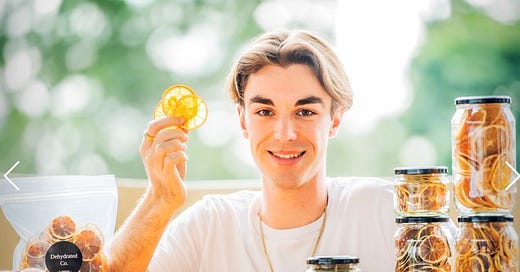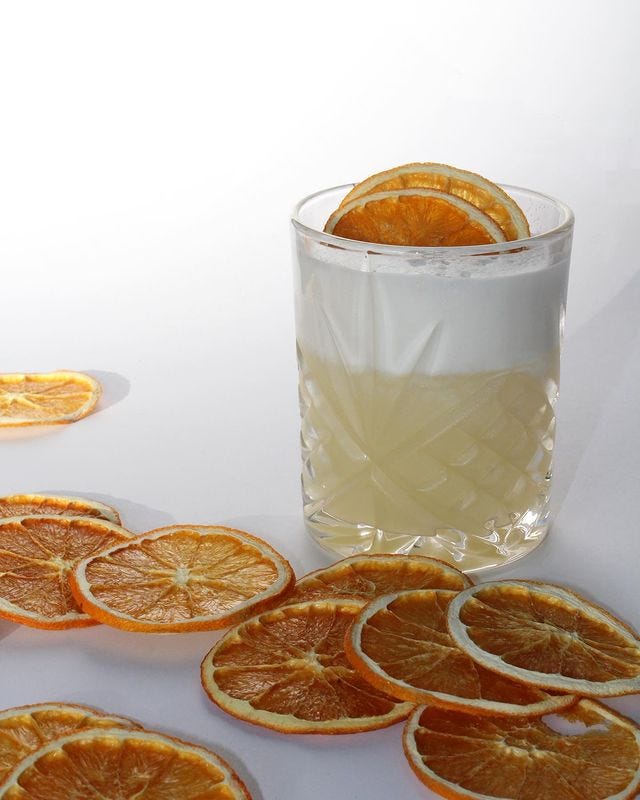How to use dehydrated fruit
Lachlan Creese of Dehydrated Co. makes us look at dehydrated fruit in a new light
I once wrote about cosmetic filtering with UglyFood in Singapore – where buyers tend not to choose perfectly edible produce just because of their slight imperfections (think bruises, scratches and different colours) or irregular shapes.
I’ve since found eco-conscious individuals and business owners who’ve thought of different ways to use this type of produce too. Other than being sold as is or in bundles, I’ve seen them turned into juices, desserts, and ingredients for recipes.
Because of Lachlan Creese of Dehydrated Co., I can add one more method to the list – dehydrating. And the results are excellent.
Dehydated Co. is a zero-waste business in Australia that dehydrates fruit into garnishing. Lachlan gathers the fruit from sellers and farmers.
What will happen to the fruit if someone doesn’t take them? “There are high chances that the fruit would be disposed of as seconds, but it isn’t a fact,” says the founder, who won Bond University’s Transformer Launchpad competition.
“Some businesses buy seconds too, but typically because they just like the juice or flesh element of the fruit. Seconds never would make the supermarket shelf due to cosmetic filtering, but you are able to get them directly from the farmer.”
Before Dehydrated Co.
“I didn’t know anything about dehydrating, and wasn’t even a consumer of dehydrated fruit,” Lachlan admits.
“I have always known it to be a method of preserving food, but nothing much else.”
All that has changed. “My standout lesson so far is that there is no bulletproof method of dehydrating, that every batch will be slightly different and needs to be treated that way to create a truly great product,” he says.
“The world of dehydrating is far larger than many of us realise, myself included, but it is definitely an untapped area that I believe will continue to grow and become more of a normal occurrence.”
So how does Lachlan use his products?
“My usage of dehydrated fruit is now extremely broad,” he answers. He gives us an idea of what happened the previous week:
#1 Morning meal
“In the morning I love having a cup of tea using the dehydrated blood orange. Morning tea was a vanilla cupcake topped off with dehydrated lemon.”
#2 Snacks
“I’ll often snack on dehydrated pineapple, and I often have afternoon cocktails which use dehydrated lemon, lime and orange.”
#3 More tea
“My biggest tip would be when it comes to using the dehydrated fruit, add the amount that you need.
“Yesterday, I put three dehydrated lemon wheels in my cup of tea. As it continued to brew, I realised the mistake I had made: It was far too strong.
“I have always had an appreciation for food – good, wholesome food – and a big learning curve for me with dehydrated fruit is that it isn’t all that alike fresh fruit; the flavour is complex and concentrated.”
Lachlan welcomes your ideas. “I’d love to see users teaching me different concoctions of mixing dehydrated fruits together, especially when it comes to naturally flavouring drinks,” he says.
“But I even would love to see dehydrated fruit sneaking into traditional dishes like roast chicken, as there is something truly special to be found in dehydrated fruit.”
His thoughts
Aside from dehydration, what are Lachlan’s suggestions to help solve cosmetic filtering?
“I have always wondered what the change in consumer habits would be if imperfect fruit was either: a) not treated as ‘imperfect’ and put on the market shelves with all of the ‘perfect’ fresh produce, or b) if side-by-side ‘perfect’ and ‘imperfect’ fruit were presented on the market shelves at different price points, with the ‘imperfect’ fruit discounted,” he muses.
“I am confident that if consumers were offered (for example) lemons at half price for being ‘imperfect’, that you’d find a change in consumer habits and they’d start to gravitate towards the cheaper item.
“The cost of living continues to skyrocket, and keeping only everything ‘perfect’ on the market shelves isn’t helping anyone.”
So try to give these wonderfully “imperfect” fruit another look, because they deserve it.
Until then, here’s another round of tips
Ready to give dehydrated fruit a go? Lachlan says to:
#1 Remember the ends
“Don’t see the ends of the fruit as a burden, but rather a blessing (even if you don’t dehydrate them, use a microblade to take the zest of the rind and use it to make something wonderful).”
#2 Thin is good in this case
“Try to keep your slices thin, from 3 to 5mm. If anything sticks during the dehydrating process, that’s okay. Break it up and you now have a fantastic crumble!”
#3 Dehydrating the fruit yourself?
“If you finish dehydrating your products and after a few days you notice them starting to go soft, don’t put them out. Put them straight back in the dehydrator and give them more time. (A full cycle should typically be no less than 14 hours at 65 degrees Celsius.)”
Plus: “When it comes to storing dehydrated fruit, there are few important elements that ensure the longevity of the dehydrated product.” They include:
#4 Saying no to the sun’s rays
“Store them in a dry cool space out of direct sunlight.”
#5 Choosing your containers
“Make sure to use high quality airtight glass jars for long-term storage.”
#6 Lessening their exposure
“Take the fruit out and close the lid straight away. Don’t leave the lid off as the dehydrated fruit is desperate to drink up all of the moisture in the air.”
It makes a difference
To Lachlan especially.
“As founder of Dehydrated Co., I love being able to see people use my products. It’s the smile when someone tells me how much one little lime wheel completely changed their drink that I adore,” he says.
“In a business sense my motivator originally and still is to make dehydrated fruit all-natural and affordable. It was only in the process of making it that I realised it could be completely waste-free too, and that’s what sparked joy for me.”
Learn to use dehydrated fruit and it could soon be the same for you.
Find Lachlan and Dehydrated Co. here and on Facebook and Instagram.





